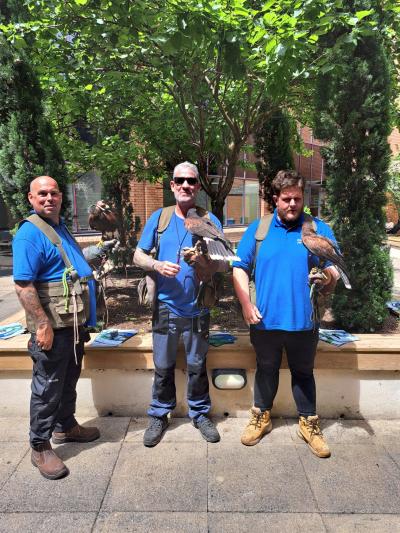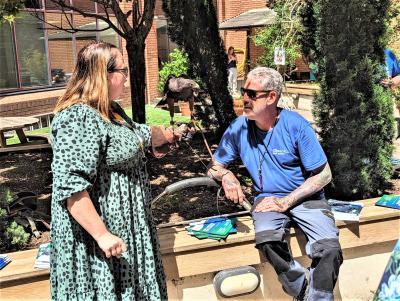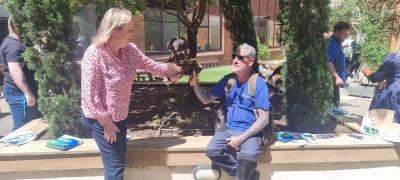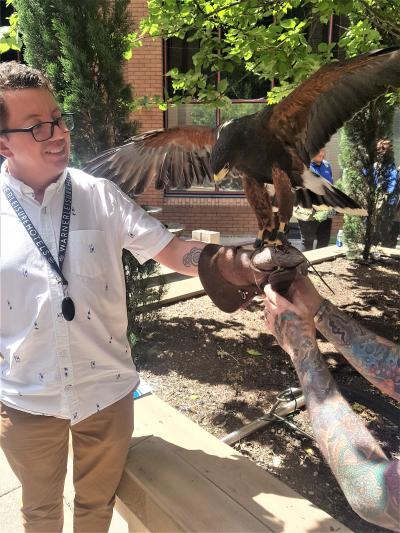We’ve had some brilliant news. Not only have we been shortlisted in the Large Company of the Year category at the 2023 National Pest Awards, but Alan Day, Team Leader of our Falconry Team, has been named a finalist in the Pest Controller of the Year category. I must say, this nomination is richly deserved.
When we first started to think about our own falconry team eight years ago, it was a bit of a gamble. Alan clearly had the passion and knowledge required but we were not sure there was a large enough market to make it cost-effective.
He worked solo to start with and only flew the birds commercially two days a week, but things have changed! There are now four handlers with their own birds, and they work every day of the working week.
This success is built on two things:
- Customers can see the results when birds are regularly flown at their site
- Alan’s infectious enthusiasm for his hawks and their ability to control nuisance birds
It is the second of these that has really helped us to promote the service to new customers.
Many companies can’t initially see how flying a bird at a site once or twice a week will solve their bird problem. This is where Alan’s knowledge and experience really comes into play. He visits the company, either alone or with another member of the team, gives a demonstration and answers their questions.
A case in point, Alan and Mark recently visited the head offices of Bourne Leisure Ltd. in Hemel Hempstead. This company operates several holiday sites around the country under the names Haven Holidays and Warner Leisure Hotels, so pest control is very important to them. They took three Harris hawks – Heidi, Herman and Dora – and, in addition to flying the birds and answering the questions, staff were able to meet the birds and get a selfie.
Many people have never heard about falconry as a pest control method, so creating a connection between the client and the bird (and the team) helps to dispel any concerns they may have about their ability to keep a site free from nuisance birds. There is something about the majesty and strength of the Harris’ hawk that really hits home to people. Read about a similar visit to AM Surveying & Block Management.
If I’m honest, before talking to Alan, I knew only the basics about falconry. When we had a site with a bird problem, we would subcontract to a professional falconer, but the idea of bringing that service in-house had never really occurred to us.
However, since meeting the birds and seeing the results, I, like our clients, am completely converted to the effectiveness of these magnificent birds.
So, is it…
Falconry or hawking?
I say falconry but it’s probably better to describe what the bird team does as hawking because they use Harris’ hawks. In fact, the terms are now essentially interchangeable and, since hawking has other less savoury meanings, it's more common to use the term falconry.
Origins of falconry?
Falconry probably arrived on the British Isles in around AD 860 and, by the time of the Normans, it was a sport of the aristocracy. It became part of the curriculum for sons of the gentry alongside riding and archery. However, the arrival of gunpowder meant shooting largely replaced it as a sport and means of capturing food. By the beginning of the last century, falconry was largely extinct on these isles.
Today, there is a resurgence. Harris’ hawks were introduced in the late 1960s and, unlike other birds of prey, they will work in groups. This made the sport of falconry more sociable, and it allowed people to develop falconry as a pest control technique for use in urban areas.
Falconry as pest control
As the name suggests, birds of prey are top predators. Their natural instinct is to catch and eat birds and mammals. This isn’t much help if you are trying to use them for pest control because, once a bird has found a meal, it will not return to its handler for hours, sometimes days.
What we use as pest controllers, isn’t the hawk’s natural flair for killing, but the nuisance bird’s innate wariness of birds of prey. Pigeons, gulls, etc. know that a Harris’ hawk or Peregrine falcon is a threat to themselves and their nest. If they see a hawk or falcon regularly flying at a site, they will assume that the bird is nesting locally and therefore the site isn’t safe for roosting.
Advantages of falconry
Firstly – it can complement or even reduce the need for bird spikes, nets, etc. These bird control techniques can be highly effective, but they will be far more effective if you can reduce the bird flock initially. Our team arrives on a site, takes the bird out of the van and lets it fly around the site. Then they get back into the van.
Secondly – long-term solution. Roosting birds have many options in urban areas, so why would they choose one where they know there is a risk of predation by a bird of prey? This even works when breeding pairs have traditionally returned to the same site for years.
Thirdly – no chemicals and no traps. This is a humane, environmentally friendly form of pest control. The aim is always to disturb the pest birds, never to harm them.
As we all look for more sustainable ways to do our business, it is ironic that one of the most efficient weapons in our arsenal isn’t a hyper-modern bird-scaring device, but an activity that goes back millennia.
Alan and the bird control team regularly produce short videos that show the effectiveness of pest control using hawks. This recent one from Watford provides a clear summary of what happens when the team arrives and you can see the effect the birds have, even when they are just sitting on the top of the van! Click here.
If you have a problem with birds are your property, contact us today on 0800 056 5477



